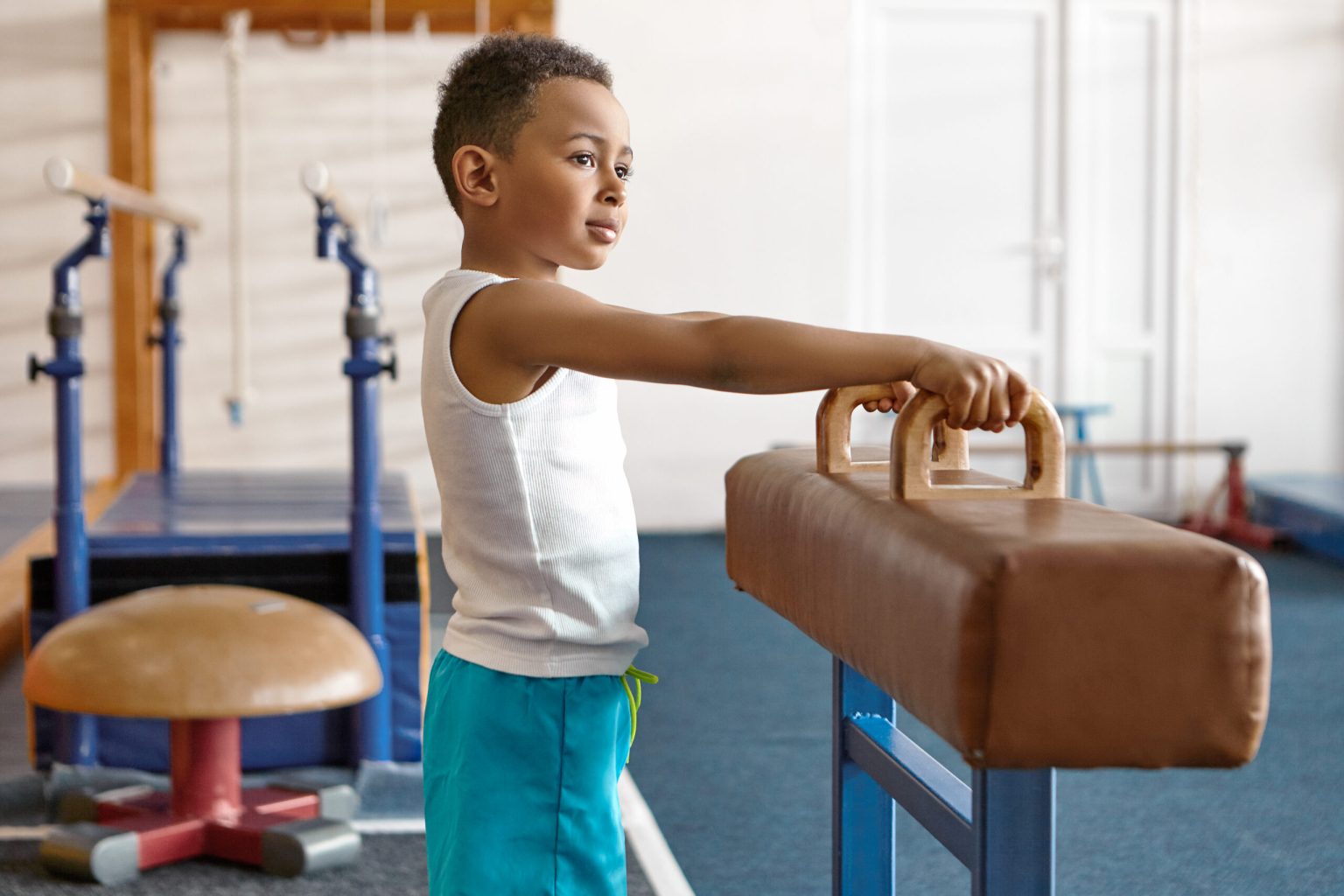Understanding Body Awareness in Autism
Body awareness is an essential aspect of development, allowing individuals to understand their body in space, process physical sensations, and regulate emotions. For children with autism, body awareness is often a challenging skill to develop, impacting their motor skills, social interactions, and daily functioning. Applied Behavior Analysis (ABA) therapy offers a structured approach to improving body awareness in autistic children through various interventions and targeted exercises. This article delves into how ABA therapy supports body awareness and the myriad ways it benefits children with autism.
The Connection Between ABA Therapy and Body Awareness
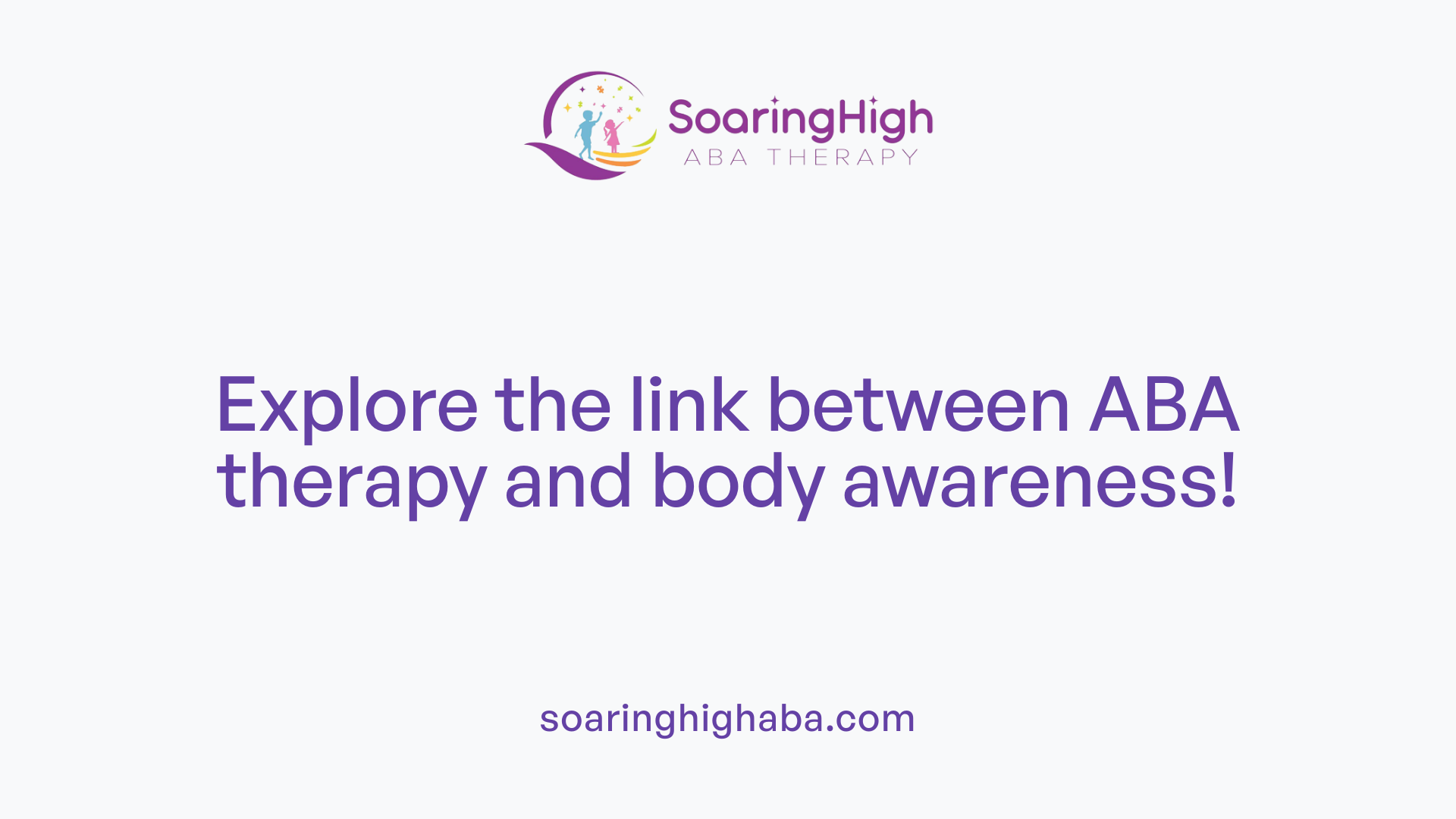
Understanding ABA therapy and body awareness
Applied Behavior Analysis (ABA) therapy plays a significant role in enhancing body awareness in children with autism. By utilizing structured interventions, ABA therapy focuses on improving motor skills and helping children understand their body positions in relation to their environment.
This therapy is essential because many autistic children face challenges with proprioception, or the sense of body awareness. They often struggle to know where their body is situated in space, which can lead to clumsiness and difficulty with physical activities. Through repeated practice and reinforcement of gross motor skills—such as engaging in activities like jumping jacks—ABA addresses these challenges effectively.
Improving interoceptive awareness
In addition to body awareness, ABA therapy significantly enhances interoceptive awareness (IA). Interoception is the ability to perceive internal bodily signals, such as hunger or emotional states, which is crucial for self-regulation and overall well-being. Many individuals with autism may have difficulty recognizing these signals, leading to stress and anxiety.
Targeted exercises can help cultivate interoceptive awareness. For instance, body scans and mindful breathing exercises can promote better recognition of bodily sensations. Enhanced IA allows children to self-regulate their emotions more effectively and manage their physical needs, such as thirst or fatigue.
The synergy of ABA therapy in improving both body and interoceptive awareness leads to greater confidence and independence in children, significantly impacting their social communication and emotional expression.
Enhancing Physical Awareness and Motor Skills
How does ABA therapy enhance physical awareness and motor skills in children with autism?
ABA therapy enhances physical awareness and motor skills in children with autism through structured programs aimed at developing specific motor skills. These programs break down essential skills into manageable steps that align with individual abilities. This focused approach allows children to progress at their own pace, facilitating their learning and mastery of functional motor skills crucial for daily activities like grooming and getting dressed.
One effective exercise employed is the karaoke walk, which helps children practice posture and stability while having fun. This not only boosts their body awareness but also combines physical activity with stimulation of social interaction.
In addition to exercises, ABA therapy integrates techniques designed to improve emotional regulation and communication skills, creating a well-rounded developmental experience. This holistic growth process ensures that as children enhance their physical abilities, they also gain vital life skills, fostering greater independence in their everyday routines.
The role of exercises in ABA therapy
Exercises play a pivotal role within ABA therapy, contributing to improvements in both physical and mental aspects of a child's development. Enhanced focus and attention brought about through physical activities correlate with better body awareness. Exercises targeting proprioception, balance, and coordination are integral, tailored to meet each child's unique needs, further reinforcing their learning experience.
Implementing targeted interventions such as mindfulness check-ins and body scans can also elevate awareness of bodily sensations. These activities help children recognize their internal states, improving interoceptive awareness and aiding in emotional regulation. Therefore, the combination of structured exercises and therapeutic techniques in ABA therapy means that children not only develop motor skills and body awareness but also grow in their ability to self-regulate and interact socially.
Understanding Interoception's Role in Autism

What is interoception, and why is it significant for individuals with autism in terms of body awareness?
Interoception refers to the internal sensory system that helps individuals perceive and respond to their physiological states. This includes sensations like hunger, thirst, and emotional feelings. For children with autism, having a strong sense of interoception is crucial for developing body awareness. Many of these children struggle to recognize and interpret their bodily cues, which can lead to significant challenges in emotional regulation and self-care practices.
Research has revealed that autistic individuals often exhibit lower interoceptive accuracy, particularly evident in tasks measuring heartbeat detection. This means they might have difficulty gauging their internal bodily signals accurately. Interestingly, many report heightened interoceptive sensibility—awareness of their internal sensations—which can sometimes paradoxically contribute to emotional dysregulation when they are unable to identify these emotions accurately.
Challenges faced by autistic individuals
The difficulties associated with interoception in autism create various challenges:
- Emotional Regulation: Struggling to recognize their feelings can exacerbate issues with managing emotions, which can lead to increased anxiety and stress.
- Self-Care: Misinterpretation of bodily signals can also interfere with personal needs like hygiene and eating, impacting overall health.
- Social Interactions: These interoceptive differences may hinder the ability to empathize or take the perspective of others, often impacting social relationships.
To counter these challenges, targeted interventions are essential. Mindfulness practices and sensory activities—such as body scans, deep breathing exercises, and mindful check-ins—can enhance interoceptive skills. Such strategies promote better awareness of bodily sensations, fostering a deeper connection between emotions and physical well-being.
Integrating Body Awareness Therapy with ABA
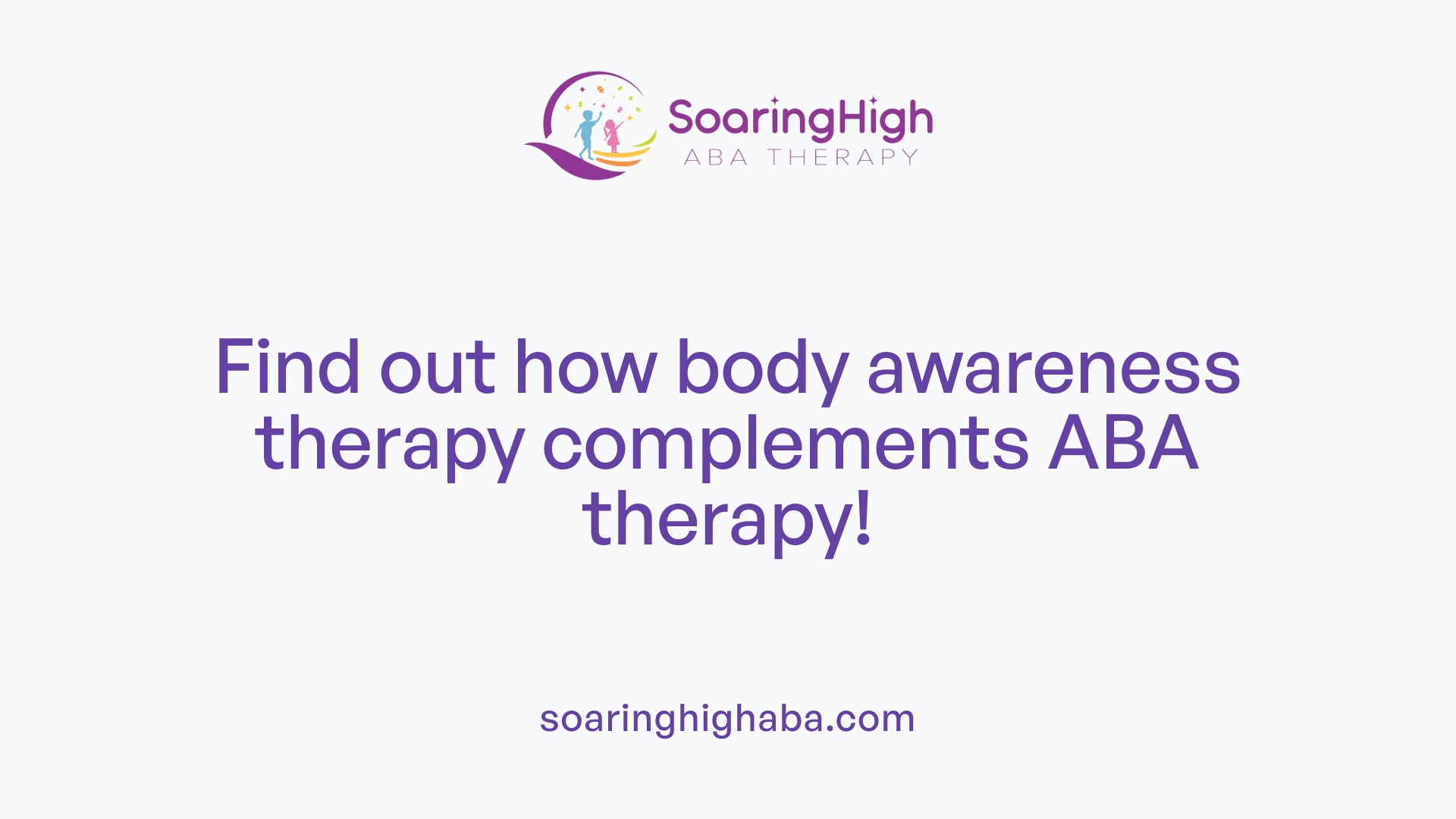
How does body awareness therapy integrate with ABA therapy and other therapeutic modalities to benefit individuals with autism?
Body awareness therapy skillfully integrates with Applied Behavior Analysis (ABA) therapy and various other therapeutic approaches to create a holistic framework for children with autism. This combination not only focuses on improving motor skills and spatial awareness but also enhances emotional regulation.
Structured activities within body awareness therapy are designed to boost proprioception, balance, and coordination—essential elements for children facing developmental delays. These activities work hand-in-hand with ABA techniques, which also emphasize exercise as a means to enhance focus and attention. By intertwining these modalities, therapists can provide personalized interventions that address unique sensory processing challenges, catering to the individual needs of each child.
Starting interventions early, ideally between 9 months to 7 years, is vital. Research shows that early engagement in these therapies leads to substantial improvements in motor skills, self-confidence, and overall development. The synergistic effect of integrating body awareness therapy with ABA and occupational therapy creates a comprehensive support system, elevating both cognitive and physical capabilities in individuals with autism.
Benefits of a holistic method
The strength of a holistic method lies in its comprehensive approach to therapy. Here are several key benefits:
- Enhanced Motor Skills and Coordination: Improved body awareness contributes to better physical capabilities, essential for everyday tasks.
- Greater Emotional Regulation: By fostering interoceptive awareness, children learn to recognize internal bodily signals. This aids in managing emotions and reducing anxiety.
- Increased Independence: As children develop spatial awareness and motor skills, their confidence encourages greater independence in various settings.
- Customized Interventions: A holistic approach allows for targeted strategies, such as mindfulness practices and visual supports, that cater specifically to the child's unique needs.
The Pinnacle Blooms Network demonstrates a significant improvement rate of 97%, showcasing the effectiveness of this integrative approach. Body awareness therapy, when combined with ABA, not only promotes physical health but also supports emotional well-being, making it a valuable method for helping children with autism.
Improving Emotional Regulation Through ABA
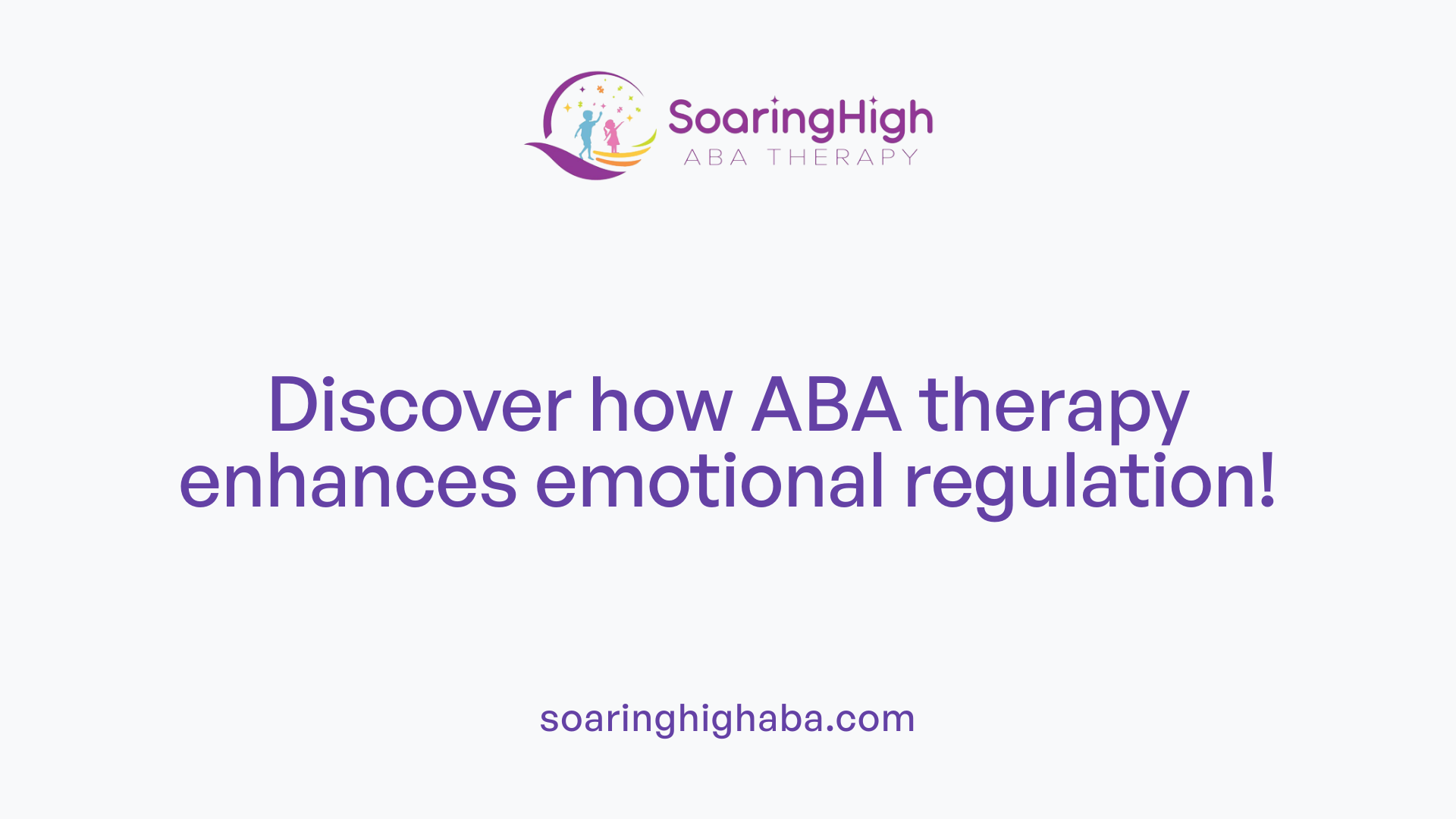
How Can ABA Therapy Methods Help in Understanding Bodily Sensations and Achieving Emotional Regulation for Those with Autism?
ABA (Applied Behavior Analysis) therapy significantly aids individuals with autism in recognizing bodily sensations and managing their emotions through a focus on interoceptive awareness. Interoception is the ability to perceive internal bodily states, such as hunger or anxiety. By enhancing this vital skill, children can learn to better identify what they feel physically and emotionally, which is essential in emotional regulation.
Therapists deploy various strategies to support this learning. Role-playing and social stories help break down complex emotions, allowing children to understand their triggers. For example, a child may learn to recognize that feeling fidgety could be a sign of anxiety. This understanding provides them with a framework for appropriate emotional responses, which diminishes the likelihood of emotional outbursts.
In addition to these methods, coping strategies and positive reinforcement are incorporated into therapy sessions, which encourage resilience. This support cultivates emotional management skills, making it easier for children to cope with daily challenges. By enhancing the understanding of their emotions and social cues, children become better equipped to navigate interpersonal relationships, which in turn fosters their overall emotional intelligence.
Additional Emotional Regulation Strategies
Various structured activities within ABA therapy also target emotional regulation. Here are a few examples:
| Strategy | Description | Benefits |
|---|---|---|
| Mindfulness Practices | Techniques such as deep breathing and body scans to enhance awareness. | Improves self-regulation and reduces anxiety. |
| Visual Supports | Tools like emotion charts help children identify emotions more clearly. | Enhances recognition and response to emotions. |
| Role-Playing Scenarios | Acts out situations that may trigger anxiety or stress. | Teaches appropriate reactions in real-life contexts. |
These therapies not only address emotional regulation but also positively impact daily functioning, enabling children with autism to lead more fulfilling lives.
Addressing Essential Social Skills with ABA
How does ABA therapy address essential skills for developing body awareness, such as social skills and non-verbal communication?
ABA therapy is specifically designed to enhance body awareness in children with autism by focusing on essential social skills. This approach involves structured interactions and targeted interventions tailored to the individual developmental stages of each child. By recognizing and interpreting social cues and body language, children learn to engage more effectively with others.
Activities like yoga and physical exercises are incorporated into ABA therapy to improve proprioception.
These exercises not only aid in enhancing balance and coordination, but they also boost motor planning, which is critical for body awareness development. The structured nature of the therapy promotes a safe environment for children to practice and refine their social interactions.
Furthermore, integrating Body Awareness Therapy and Occupational Therapy into the regime provides a holistic framework aimed at improving cognitive development alongside motor skills. The focus on these interconnected areas facilitates greater physical coordination, self-regulation, and confidence in social situations.
By employing these diverse strategies, ABA therapy fosters social engagement and enhances communication skills, equipping children with autism and developmental delays for better interactions in their daily lives.
Exercises in ABA Therapy for Body Awareness
Types of Exercises Used
In ABA therapy, various exercises are deployed to bolster body awareness among children with autism. One effective method is karaoke walks, where children walk while singing to a rhythm. This encourages both movement and engagement, which can enhance stability and posture.
Additionally, body scans and mindful check-ins are employed to help children recognize and interpret their internal bodily sensations. These mindfulness practices not only support physical awareness but also contribute to emotional regulation.
Impact on Posture and Stability
Exercises in ABA therapy significantly impact children’s posture and stability. By focusing on structured physical activities, such as yoga poses and balance exercises, children learn to better align their bodies, improving their overall motor skills.
This improvement in stability is linked to better proprioceptive awareness, which allows children to navigate spaces more confidently, reducing clumsiness. As they grow in coordination and spatial awareness, children are better equipped to tackle everyday tasks.
Overall, enhancing body awareness through these targeted exercises fosters independence and boosts confidence, improving their quality of life.
Yoga's Role in Body Awareness for Autism
Benefits of Yoga for Autism
Yoga offers several advantages for children with autism. It enhances body awareness, which is vital for understanding their physical presence and movements. This awareness serves as a foundation for improved proprioception—recognizing where their body is in space. Enhanced body awareness positively influences other skills such as social communication and emotional expression and helps reduce anxiety levels. Practicing yoga can also foster relaxation, which is crucial for children dealing with the stresses of daily life.
Integration with ABA Therapy
Integrating yoga with Applied Behavior Analysis (ABA) therapy enhances its overall benefits. ABA therapy targets critical areas like body awareness through various exercises, including creative movement and relaxation techniques that align well with yoga principles. Exercises incorporated in ABA, such as karaoke walks, complement yoga practices by improving posture and stability, furthering the development of motor skills and spatial awareness. Both modalities collectively support better emotional regulation and focus, essential for daily functioning in children with autism.
Overall, using yoga as part of a broader therapeutic approach, such as Body Awareness Therapy at Pinnacle Blooms, can transform children’s understanding of their bodies, promoting a sense of independence and improved life skills.
Interoceptive Awareness and Emotional Regulation
What is the Impact on Emotional Processing?
Interoceptive awareness is crucial for children with autism, as it enables them to sense and understand their internal bodily states. This awareness significantly impacts emotional processing, as many children with autism struggle to identify and articulate their emotions.
These difficulties can lead to challenges in empathy and perspective-taking, affecting their social interactions. For instance, if a child cannot recognize feelings of anxiety or discomfort linked to physical sensations, they may encounter greater difficulties in managing their reactions in social settings.
What Strategies Can Improve Interoception?
Implementing targeted interventions can greatly enhance interoceptive awareness in autistic individuals. Here are some effective strategies:
- Mindfulness Practices: Activities like body scans and deep breathing encourage children to tune into their bodily sensations, helping them recognize internal signals.
- Visual Supports: Utilizing charts or images can assist in connecting specific emotions to physical sensations, making it easier for children to identify feelings.
- Regular Check-ins: Implementing routines for emotional and physical check-ins can provide structured opportunities for children to recognize their needs.
By employing these strategies, children can improve their interoceptive awareness, leading to better emotional regulation and overall well-being.
Improving Motor Skills and Coordination
Activities for Spatial Awareness
Children with autism often face challenges with body awareness, which can contribute to clumsiness and hinder their development. Engaging in targeted activities can significantly improve their spatial awareness.
One effective activity is the karaoke walk, where children practice walking while maintaining rhythm and posture. This exercise not only enhances balance but also builds awareness of bodily movements in space. Other activities, such as yoga or dance, can promote body alignment and coordination, fostering confidence in their physical abilities.
Motor Planning Development
Motor planning is critical for daily tasks, and enhancing this skill can lead to greater independence for children on the autism spectrum. Incorporating structured activities through approaches like Body Awareness Therapy helps to develop these skills.
Exercises that focus on proprioception, such as obstacle courses or balance games, can strengthen motor planning abilities. For example, when children navigate through different surfaces or textures, they learn to appreciate how their body interacts with the environment.
A comprehensive approach that combines various therapeutic modalities can lead to remarkable improvements in both motor skills and coordination. High rates of success, such as those reported by Pinnacle Blooms, illustrate the effectiveness of these techniques in fostering essential skills for everyday activities.
Early Intervention in Body Awareness Therapy
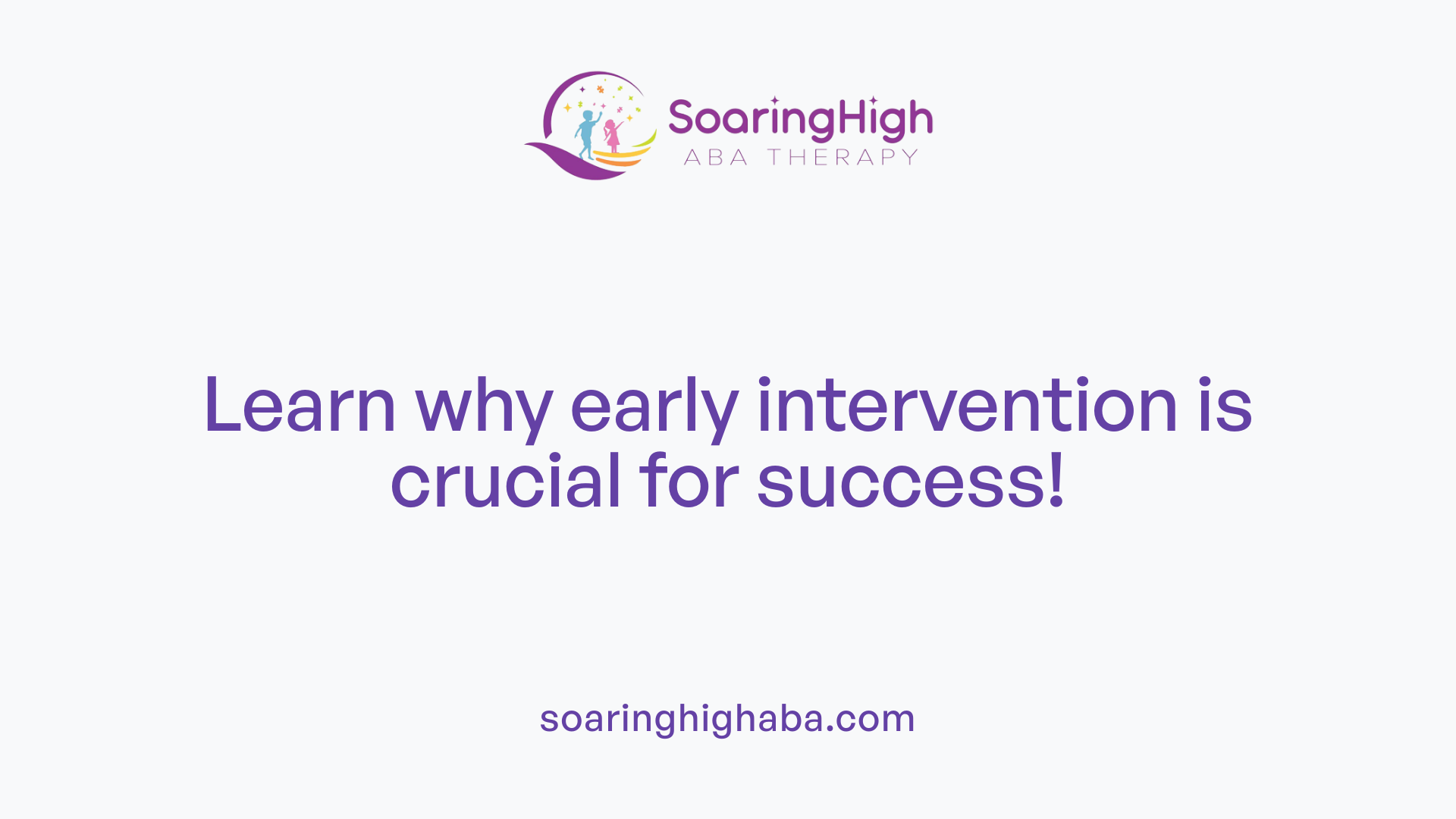
Age-related outcomes
Starting Body Awareness Therapy early, particularly between 9 months and 7 years, can lead to significant improvements in a child's abilities. Early intervention is crucial because the foundational skills developed during these formative years impact a child's physical health, motor skills, coordination, and overall independence later in life. At Pinnacle Blooms, personalized therapy approaches have shown a remarkable improvement rate of 97% in children undergoing tailored body awareness interventions.
Importance of starting early
The importance of initiating therapy during early childhood cannot be underestimated. During these years, kids are naturally more adaptable and responsive to new learning experiences. Engaging with Body Awareness Therapy early allows children with autism to enhance their body awareness, develop proprioception, and improve their social skills, which are essential for daily activities.
Implemented through structured activities like karaoke walks and mindfulness practices, early intervention sets a foundation for improved emotional regulation by fostering better recognition of internal bodily signals. As children progress, they gain confidence and independence, key elements in their overall development and interaction with their surroundings.
| Aspect | Benefits of Early Intervention | Evidence of Effectiveness |
|---|---|---|
| Age Range | 9 months to 7 years | Proven improvement rate of 97% |
| Skills Developed | Body awareness, motor skills, emotional regulation | Tailored therapeutic modalities |
| Impact | Enhanced independence and confidence in daily tasks | Research supports long-term benefits of early care |
Incorporating Mindfulness in ABA
Mindfulness Techniques
Mindfulness techniques are increasingly integrated into Applied Behavior Analysis (ABA) therapy for children with autism. These practices aim to enhance both mental and bodily awareness, which are pivotal for emotional regulation and social interaction. Techniques such as body scans, deep breathing, and mindful check-ins help children focus on their present experiences, promoting a better understanding of their internal states.
Connection with Body Awareness
The incorporation of mindfulness not only fosters emotional intelligence but also significantly boosts body awareness. By practicing mindfulness, children learn to recognize their bodily sensations—such as tension or relaxation—that can guide their emotions. This heightened awareness can mitigate issues related to proprioception and interoception, leading to fewer anxious responses to daily stimuli.
Mindfulness exercises strengthen the connection between a child’s emotions and physical state, which enhances their ability to interpret internal cues effectively. For instance, a child may learn to identify when they feel hungry or overwhelmed, allowing them to respond appropriately, thereby improving their overall well-being.
In summary, blending mindfulness techniques within ABA therapy offers a comprehensive approach to helping children with autism develop better body awareness and emotional regulation.
Balancing Physical and Cognitive Growth
Holistic Development Strategies
Yoga and Body Awareness Therapy, like that offered by Pinnacle Blooms, promote a comprehensive approach to improve the well-being of children with autism. These strategies emphasize both physical and cognitive development. Through structured activities that enhance body awareness, motor skills, and proprioception, children can achieve significant milestones in their overall growth.
For instance, incorporating exercises such as karaoke walks and body scans in therapy helps improve not just physical coordination, but also cognitive skills such as focus, attention, and emotional regulation. By bridging these areas, children become more adept at recognizing their body’s signals and managing their emotions effectively.
Importance of Cognitive Skills
Cognitive development is vital for children with autism, particularly in areas such as emotional awareness and social interactions. Enhanced cognitive skills help children interpret internal bodily signals, which can improve their responses to feelings like hunger, stress, or excitement. The synergy between physical exercises and mental health practices, such as mindfulness, fosters an environment where children learn to articulate their emotions and strengthen their social-communication skills.
Furthermore, early interventions focusing on both body awareness and cognitive strategies can lead to more profound improvements, as reflected in Pinnacle Blooms' remarkable 97% success rate. This holistic approach not only enhances motor skills and balance but also builds confidence and independence in everyday tasks, ultimately paving the way for a bright future.
Proprioception and Everyday Tasks
Understanding Body in Space
Proprioception, our ability to perceive the position of our body parts in relation to each other and the environment, is essential for everyone, especially children with autism. For these children, difficulties in proprioception often manifest as clumsiness or challenges with balance and coordination.
Improving body awareness through specialized interventions such as Body Awareness Therapy Technique at Pinnacle Blooms can greatly enhance a child's proprioceptive skills. These therapies include structured activities tailored to boost physical capabilities, leading to better spatial awareness and overall motor skills.
Enhancing Daily Task Performance
By integrating exercises like karaoke walks and mindfulness practices, children can improve their stability and body control, which directly impacts their ability to perform everyday tasks. Activities focusing on proprioception pave the way for success in areas such as personal hygiene, sports, and navigating social environments.
As they gain confidence in their body awareness, children with autism can improve their independence. Early intervention—ideally between 9 months and 7 years—results in substantial enhancements, allowing them to engage more fully in daily activities and promoting overall physical well-being.
Social Stories and Identifying Emotions
What are the benefits of body awareness for children with autism?
Body awareness is fundamental for children with autism, particularly regarding their proprioception—the ability to comprehend the position of their body in space. This awareness is crucial, as deficits can lead to difficulties with coordination and stability, often resulting in clumsiness. Through specific exercises, like karaoke walks, children can engage in activities that enhance their posture and stability, ultimately improving their body awareness.
How does ABA therapy aid in improving body awareness?
Applied Behavior Analysis (ABA) therapy is designed not just for physical improvement, but for enhancing mental focus and attention as well. By incorporating exercise into therapy, children with autism experience improvements in their body awareness, which correlates with increased emotional expression and reduced anxiety. The structured activities under ABA can significantly boost a child's motor skills, balance, and coordination, necessary for independence in daily tasks.
What is interoception and its significance?
Interoception involves sensing internal bodily states crucial for emotional regulation and maintaining overall health. Many individuals with autism face challenges in recognizing these internal cues, which may result in heightened anxiety and difficulties in daily functioning. Enhancing interoceptive awareness through mindfulness practices and targeted strategies helps children recognize internal sensations, allowing for better emotional self-regulation and management of physical needs like hunger.
What interventions can support interoceptive awareness?
To improve interoceptive skills, interventions such as body scans, deep breathing exercises, and mindful check-ins can be incredibly beneficial. These practices aid children in connecting bodily sensations to their emotions, which is vital for developing empathy and understanding social cues.
| Therapy Type | Focus | Benefits |
|---|---|---|
| Body Awareness Therapy | Proprioception | Enhances motor skills and independence |
| ABA Therapy | Body awareness & interoception | Improves focus, emotional expression, and reduces anxiety |
| Mindfulness Practices | Interoception | Aids in recognizing and regulating internal cues |
Starting these therapies early, ideally between 9 months and 7 years, can make a substantial difference in a child's development. With proven success rates—like those from Pinnacle Blooms, reporting a 97% improvement rate—these therapies are valuable in supporting children with autism in their journey toward greater self-awareness and emotional well-being.
Sensory Processing Needs and ABA Therapy
Addressing sensory challenges
Children with autism often face unique sensory processing challenges, significantly affecting their day-to-day functioning. Body awareness is crucial; it ties closely to proprioception, which is fundamental in understanding one’s position in space. Techniques used in Applied Behavior Analysis (ABA) target these sensory needs effectively, particularly through activities designed to enhance body awareness and motor skills.
Integration with ABA techniques
Various exercises, such as karaoke walks and body scans, are integral to ABA therapy. They help improve posture and stability, which in turn can enhance body awareness. Additionally, mindful practices promote interoceptive awareness, guiding children in recognizing their internal signals—be it emotional or physical.
Research shows that focused interventions can significantly improve coordination, balance, and self-regulation. By starting therapy early, children may better develop essential skills for daily activities, ultimately increasing their confidence and independence.
The efficacy of programs like Body Awareness Therapy at Pinnacle Blooms showcases a high improvement rate, indicating the successful implementation of these techniques. In summary, combining sensory processing interventions within ABA therapy enhances overall therapeutic outcomes for children with autism.
Advancements in Body Awareness Through ABA Therapy
ABA therapy provides a robust framework for enhancing body awareness in children with autism, addressing both physical and emotional aspects critical to their development. By incorporating diverse strategies such as mindfulness, yoga, and targeted exercises, ABA therapy bridges the gap in sensory understanding and motor skills that many autistic children face. Integrating this therapy with other modalities like body awareness and occupational therapy ensures a comprehensive approach to support these children in their early years, setting them on a path toward greater independence and improved quality of life. Through continued research and tailored interventions, ABA therapy remains a cornerstone in promoting the holistic development of autistic children.
References
- How is Exercise Used in ABA Therapy?
- Understanding Interoception and Autism: Key Insights
- Transforming Lives with Body Awareness Therapy Technique for ...
- Autism, Interoception, and How to Improve Your Awareness
- Applied Behavior Analysis (ABA) | Autism Speaks
- 6 Life-Changing Benefits of ABA Therapy for Children with Autism
- [PDF] Emotional Regulation Strategies
- ABA Therapy's Role in Emotional Regulation
- Understanding Interoception and Autism: Key Insights
- Interoception and mental wellbeing in autistic people














































